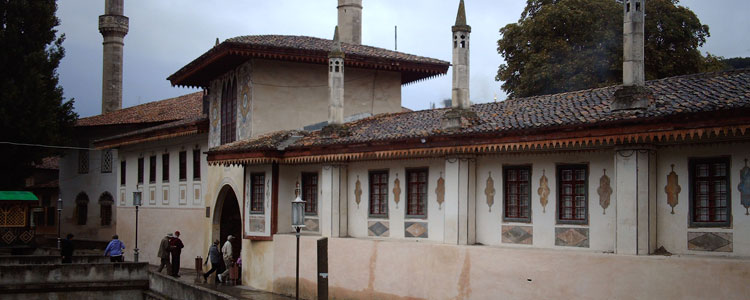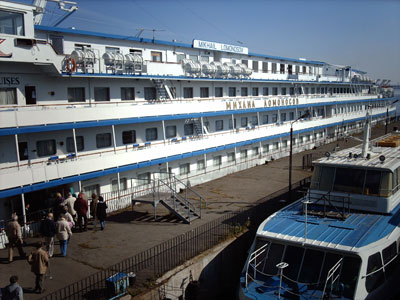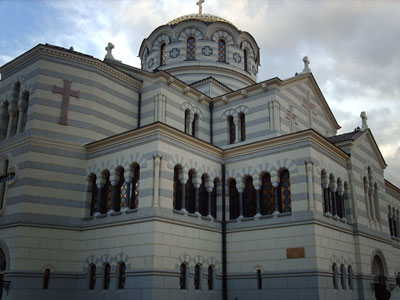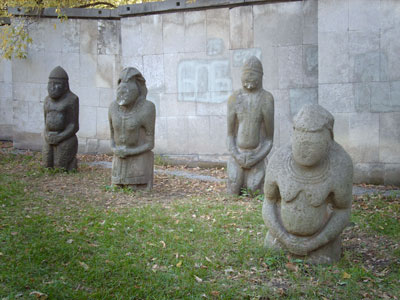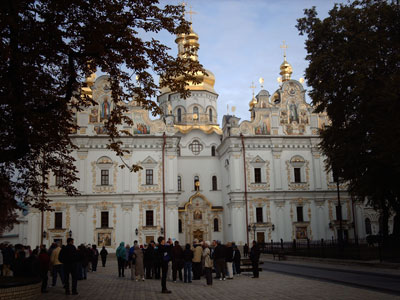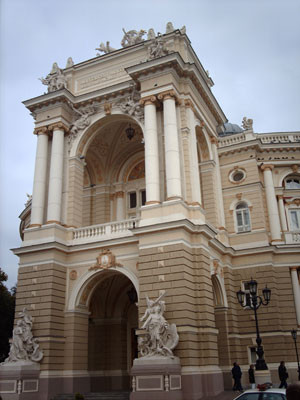Cruising Ukraine’s Dnieper River
Lynn Remly; Hudson, OH
Most travelers head for foreign parts to explore and learn things they didn’t know before. Those of us who joined Viking River Cruises’ “Footsteps of the Cossacks” river trip from Odessa to Kiev (Oct. 6-17, 2010) learned a great deal about a country that is relatively little visited: Ukraine.
The second-largest country in Eastern Europe, Ukraine is also one of the oldest. As we cruised the Dnieper River northward from Odessa to the capital, Kiev, we traced the country’s harsh history, from the early Greek colonies in Crimea through the romantic Cossacks to the calamities of the 20th century.
Ukraine has been a free country for only 19 years, and we observed firsthand how the country is making its way in the modern world after the nightmares of Stalin and Soviet control.
Life on board
After an efficient pickup at the Odessa Airport (transfers can be purchased as part of the cruise package), we joined our ship, the Mikhail Lomonosov.
The large majority of passengers were American, but there was a sprinkling of Canadians, Dutch and Brits as well. In the course of chatting, I realized that many of the passengers were repeat customers with Viking River Cruises (Woodland Hills, CA; 800/304-9616). One couple had sailed with Viking 14 times. Such loyalty gave me a lot of confidence in this cruise.
The Lomonosov has 102 cabins, all outside and all with private facilities. Despite the attractive decorating, however, the boat’s structure made it uncomfortable in many ways. The cabins were very cramped and the walls between them thin enough that I could hear my neighbor in the next cabin snoring through the night.
The brochure indicated that the cabins had “Pullman beds” and “yacht-style showers.” The bed was narrow though comfortable, but the shower was only a handheld device that made getting clean a challenge, though we all managed as best we could. Viking stalwarts assured me that the river ships on other itineraries had much more spacious cabins.
Further, because the ship was small, there was little in the way of public areas. The library, for example, became a rather noisy gathering place rather than a quiet place to read, simply because there wasn’t much other space available in which to sit and talk.
The 202 passengers were divided between the ship’s restaurants, Odessa and Kiev, according to cabin locations. All meals were included, and all were excellent.
Breakfast was a buffet bar of cold and hot foods, which could be supplemented by a special order such as eggs Benedict or a cheese omelet.
Lunch included an extensive salad bar preceding soup, a main course that provided a number of selections (several designated “healthy” and some vegetarian) and a dessert. The service personnel were Ukrainian and spoke enough English to make communication easy. They were invariably pleasant and helpful.
A welcome reception and dinner filled our first evening, and the ship remained docked in Odessa overnight. A daily printed program supplied every evening at turn-down time laid out the plan for the next day.
Odessa
Our Ukrainian experience really began the next day with an included tour of Odessa. Most tours were included in the cruise price ($1,937, single), which is preferable, in my mind, to constantly being charged for extras that enable you to take advantage of the itinerary.
Particularly helpful on tours, incidentally, were the individual earphones/receivers that were distributed each day for our use. With these, we could hear the guide speaking even at a distance of many yards.
Though slightly faded in splendor, Odessa more than deserves its nickname, “The Pearl of the Black Sea.” Wide boulevards are lined with huge sycamores and chestnut trees, and beautiful classical buildings in proportion to the broad streets make for an elegant impression.
We visited the Potemkin Steps, whose 192 stairs were made famous in Eisenstein’s 1925 film “The Battleship Potemkin.” We admired the monument to the unknown soldier of World War II, guarded by a troop of school students for whom it is a great honor to stand watch. We also visited Uspensky Cathedral, the Pushkin statue, the Londonskaya Hotel and other testimonies to the rich culture and prominence of the city.
The Crimean peninsula is actually an autonomous republic under the jurisdiction of Ukraine, and it accounts for more history than any dozen other countries. Dangling provocatively into the Black sea, the territory was controlled at various times by the Cimmerians, Greeks, Scythians, Goths, Huns, Bulgars, Khazars, Kievan Rus’, Byzantine Greeks, Ottoman Turks, the Golden Horde and the Mongols.
The peninsula’s strategic ports drew the Venetians and Genoese to establish settlements there in the 13th century. Finally, the Russian Empire annexed the peninsula, ruling from the 18th to 20th centuries. This bewildering mix of ethnicities and cultures probably accounts for the sophistication of the Crimean cities we visited, a sophistication unmatched by any other destination we visited until we reached Kiev.
Though we had free time to wander the city after lunch, I opted for a quick nap to prepare for our evening at the Odessa opera house (not included), recently reopened after a complete renovation. I had a box on the fourth level for the ballet “Giselle,” but just visiting the opera house, itself, would have justified the 50-dollar price tag for the evening.
The chef prepared a light snack for those attending the 7 p.m. performance, and a late-night buffet awaited our return.
Sevastopol
That night we cruised through some very nasty weather to arrive in Sevastopol. As the home of the Soviet Black Sea Fleet, the city was closed to the public until recently; it still shelters the Russian Black Sea Fleet and Ukrainian Naval Forces.
When touring, passengers were divided between five buses. Each group stayed with the same guide and bus throughout the trip. I found this helpful in getting to know people, and since all the guides were (I heard) as good as ours, Nina, everyone was happy to stay with their group.
Our city tour took us through elegant streets to visit the Admiral Nakhimov Memorial, a monument to the commander of naval and land forces during the Siege of Sevastopol during the Crimean War (1853-1856).
At the St. Vladimir Cathedral, I purchased a couple of rushnyki for gifts. These embroidered towels — red on white in this region — had a ritual purpose in pre-Christian times, the embroidery containing the hopes for the well-being of a new baby, a son going off to war or the health of the family. Throughout our trip, we found women offering their own handiwork for sale, and it seemed like an appropriate gift item.
In the afternoon, I took an optional tour to Chersonese, a Greek colony founded 2,500 years ago. We toured the archaeological sites there — reminders of the complex trading history of the Crimea. In the evening, an additional outing to a Black Sea Fleet and Dance Ensemble performance drew a good number of our group.
The cost of these optional tours was modest, varying from $25 to $50. They were a nice supplement to the many included tours.
Remaining in Sevastopol, we drove the next day to Bakchisarai, the Ottoman capital of the Crimea during the period of Turkish rule. We toured Khan’s Palace, an example of Tatar-Muslim architecture which featured the Fountain of Tears immortalized in Pushkin’s poem “To the Fountain of the Palace of the Bakchisarai.”
After lunch, an optional tour took travelers to Balaklava Valley, site of the famous Charge of the Light Brigade during which 673 British cavalry rose directly into Russian fire, resulting in 118 men killed, 127 wounded and about 60 taken prisoner.
Later, a tour of a former Soviet submarine base, hidden in miles of tunnels, was followed by a visit to Sevastopol’s Panorama Museum, featuring a panoramic mural depicting the Defense of Sevastopol during the Crimean War.
Those not on the optional tour were free to wander through the town. Typical of the attention to detail shown by Viking throughout the cruise, at each port small cards were distributed with the ship’s location written in English and Cyrillic. If anyone got lost, they could use the card to ask for directions back to the ship.
On to Yalta
We were next scheduled to visit Yalta, 279 sea miles away, but the vicious weather kept all ships in port. The cruise director announced that we would go overland by bus to Yalta so as not to miss our excursions. Armed with boxed lunches, off we went.
The bad weather also forced postponement of our lifeboat drill. Unfortunately, it was never rescheduled. Given that almost all the passengers were new to the ship, it seemed to be a shocking lapse in safety precautions.
I was quite happy to travel overland to Yalta, knowing that we would see more crossing by bus than skirting the shore by boat. This is, indeed, one disadvantage of a cruise: you never get very far inland, so, aside from any interesting sights along the coast or the riverbank, you miss a lot.
We spent some time at Livadia, or the White Palace, the former summer palace of Tsar Nicholas II that served as the meeting place where Churchill, Stalin and Roosevelt planned the division of Europe at the end of World War II. The table at which they sat during the Yalta Conference, along with numerous photographs and memorabilia, captured that time.
Upstairs, poignant reminders of the Tsar’s family remain in the private apartments. The Tsar was a keen amateur photographer, and many of his photos hang in his private study.
The dining room, bedrooms and library can be viewed as can the Grand Duchesses’ classroom, where a number of sketches by Tatiana, Olga, Maria and Anastasia still hang.
Because of the disruption of our sailing schedule, Viking had to cancel an optional excursion to Massandra Winery, but they threw in a free tour to Aloupka Palace. Count Mikhail Semyonovich Vorontsov, the governor of what at the time was referred to as Novorussiya, or New Russia, commissioned an English architect to design a palace that combined Scottish and English Gothic design elements with Moorish architectural style. Though a rather startling combination, the palace underscores the wildly different influences on Crimean history.
A quick stop
The weather finally cleared, and we cruised into the immensely broad estuary of the Dnieper River, the third-longest river in Europe, after the Volga and the Danube. Our first call was Kherson, our ship’s home port and the home of many of the staff. This call was for operational purposes rather than for any attraction Kherson might have.
We had a pleasant walk along the tree-lined central boulevard, where local artists and craftsmen were showing their wares. This was the first time we began to understand that in following the Dnieper, we would not be viewing quaint villages and charming castles against a riverine backdrop.
One of the guides explained that when the five locks were created in the Soviet period to make the river navigable up to Kiev, the banks of the river were flooded as were all the villages along it, quaint or not. As a result, we mainly saw industrial towns with buildings dating to the Soviet period.
Cossack guest
In 1569 Ukraine fell under Polish administration and influence. During this time, most of the Ukrainian nobles converted to Catholicism while most peasants remained within the Eastern Orthodox Church. They turned to the Cossacks for which the country is famous, a group who had fled efforts to force them into serfdom in the 15th century.
Fiercely independent and proud of their valor, the Ukrainian Cossacks fought their war of independence in 1648, but the budding Cossack state, the Zaporozhian Host, was eventually divided between the Commonwealth of Poland and Russia. Under Russia, the Cossacks initially retained official autonomy and, for a time, also maintained a semi-independent republic in Zaporozhye, our next stop on the cruise.
Today, with a population of over 700,000, Zaporozhye is one of Ukraine’s largest cities, an important industrial center of the region. Zaporozhye is also known for electricity generation, and we paused for a photo stop at the Dnieper Hydroelectric Station.
People visit, however, not because of the power station but because of the region’s association with the Cossacks, whose large area of control, the sich, was centered on a fortress on Khortitsa Island in the middle of the Dnieper River.
We toured the Khortitsa Cossack Museum, which has an impressive collection of prehistoric artifacts, including some exhibits dating from the Stone Age through the Scythian period. In addition, we saw a fine display of Cossack life in dioramas, paintings, weapons and other objects.
It was getting late and chilly when we headed to the Cossack Horse Show, which included a demonstration of riding, whip handling and byplay among the performers. Unfortunately, all of the show material — no doubt very amusing — was not in English, so we couldn’t really appreciate what was going on.
After the show, we were served Ukrainian honey-and-pepper vodka (another great souvenir to take home) and a meat-and-rice dish similar to the national dish, plov, then wandered around the various stalls shopping for souvenirs.
Off the tourist track
Our ship cast off that evening for Dnepropetrovsk, founded in 1776 by Catherine the Great as part of the expansion of the Russian Empire into the lands north of the Black Sea. As Ukraine’s third-largest city, Dnepropetrovsk is heavily industrial. It was a closed city until the breakup of the Soviet Union, having been a center of nuclear and space industries.
We visited the local museum to see stone idols dating to the fifth century BC and some pieces of the Turkic Pechenegs dating to the eighth and ninth centuries. We walked to see the Saviour’s Transfiguration Cathedral, the main Orthodox church of the city.
Our next day took us to Kremenchuk, a city of which no one on our cruise had ever heard, perhaps with good reason. Our guide said that we would see “how ordinary people live,” but, overall, the stop in a town where there was nothing to see mystified most of us.
Our city tour took us to yet another hydroelectric station and, briefly, to the tiny Museum of Local Lore. Afterward we wandered into two department stores, predictably much smaller and more limited than their American and European counterparts, then went back to the bus and ship. Even with reasonably lowered expectations, the visit was disappointing.
Ukraine declared itself an independent state on Aug. 24, 1991, and when the Soviet Union ceased to exist on Dec. 26 of that year, the international community recognized Ukraine’s independence.
After centuries of warfare and destruction, there’s little wonder that this new republic should be concentrating on the basics: creating new markets, rebuilding ruined structures and shoring up a shrinking population as people emigrate to look for a more hopeful life in Canada and other Western countries.
Kiev
Our final stop was the capital, Kiev, but the itinerary allotted only a few hours for a tour of one of the finest cities in Europe, creating the biggest disappointment of the trip, further complicated by traffic interruptions that prevented our buses from stopping to take photos.
We visited St. Sophia Cathedral, begun in 1037 by Yaroslav the Wise, but only cruised by the Golden Gate of Kiev, for example, without being able to get a photo or even a good look.
I had asked about a city extension when booking but was told that I’d have to make my own arrangements (and, of course, sacrifice my prepaid airport transfer).
We did get to the Monastery of the Caves, a complex of churches and monastery buildings (many now museums) set above a labyrinth of caves once used as a burial ground for the monastery’s monks. A chapel carved into the rock and mummified bodies (covered) mark the trail through the underground refuge.
Later, some passengers elected to take the optional tour to Babi Yar, a ravine which was the site of a number of massacres carried out by the Nazis, including the massacre of over 30,000 Jews on Sept. 29-30, 1941. Since I had to be up at 2 a.m. for my morning flight home, I opted to stay on board and try to get a few hours’ sleep.
Overall, I would recommend a trip to Ukraine, though the river route has disadvantages that may or may not be offset by the pleasure of sailing one of Europe’s great rivers. For those who want to learn, this destination offers possibilities that may be unique in Eastern Europe.

